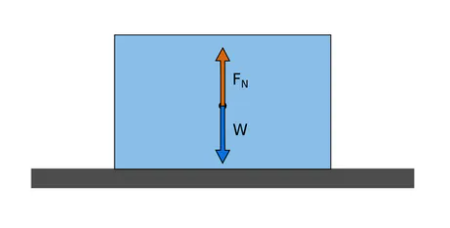1. What is a Normal Force Calculator?
Definition: This calculator determines the normal force exerted by a surface on an object in various scenarios, such as on a flat surface, an incline, with an applied force, or with friction.
Purpose: It is used in physics and engineering to analyze forces in static and dynamic situations, ensuring proper design and safety considerations.
2. How Does the Calculator Work?
The calculator operates in four modes:
Flat Surface:
\[
F_N = m \cdot g
\]
Incline (No Friction):
\[
F_N = m \cdot g \cdot \cos \theta
\]
Incline with Applied Force:
\[
F_N = m \cdot g \cdot \cos \theta \pm F_{\text{app}} \cdot \sin \theta
\]
(Negative for upward force, positive for downward force)
Incline with Applied Force and Friction:
\[
F_N = m \cdot g \cdot \cos \theta \pm F_{\text{app}} \cdot \sin \theta
\]
Where:
- \(m\): Mass (kg)
- \(g\): Gravitational acceleration (m/s²)
- \(\theta\): Incline angle (radians)
- \(F_{\text{app}}\): Applied force (N)
- \(F_N\): Normal force (N)
Unit Conversions:
- Mass: kg, lb (1 lb = 0.453592 kg)
- Gravitational Acceleration: m/s², ft/s² (1 ft/s² = 0.3048 m/s²)
- Angle: degrees, radians (1 degree = \( \pi/180 \) radians)
- Force: N, kN (1 kN = 1000 N), lbf (1 N = 0.224809 lbf)
Steps:
- Select the calculation mode (Flat Surface, Incline, etc.)
- Enter the mass (m), selecting the unit (kg, lb)
- Enter the gravitational acceleration (g), selecting the unit (m/s², ft/s²)
- For incline modes, enter the incline angle (θ), selecting the unit (degrees, radians)
- For applied force modes, enter the applied force (F_app) and its direction
- For friction mode, enter the friction coefficient (μ)
- Convert inputs to SI units (kg, m/s², radians, N)
- Calculate the normal force using the appropriate formula
- Select the desired unit for the result and view the converted value
3. Importance of Normal Force Calculation
Calculating the normal force is crucial for:
- Stability: Ensuring objects remain stable on surfaces or inclines.
- Design: Determining forces for structural integrity in engineering.
- Safety: Preventing slipping or tipping in various scenarios.
4. Using the Calculator
Examples:
- Example 1 (Flat Surface): For a mass \( m = 10 \, \text{kg} \), gravitational acceleration \( g = 9.80665 \, \text{m/s}^2 \):
- Normal force: \( F_N = 10 \cdot 9.80665 = 98.067 \, \text{N} \)
- Example 2 (Incline, No Friction): For a mass \( m = 10 \, \text{kg} \), gravitational acceleration \( g = 9.80665 \, \text{m/s}^2 \), incline angle \( \theta = 30^\circ \):
- Incline angle: \( 30^\circ = 30 \cdot \frac{\pi}{180} \approx 0.5236 \, \text{radians} \)
- Normal force: \( F_N = 10 \cdot 9.80665 \cdot \cos 0.5236 \approx 10 \cdot 9.80665 \cdot 0.8660 \approx 84.923 \, \text{N} \)
- Example 3 (Incline with Applied Force): For a mass \( m = 10 \, \text{kg} \), gravitational acceleration \( g = 9.80665 \, \text{m/s}^2 \), incline angle \( \theta = 30^\circ \), applied force \( F_{\text{app}} = 20 \, \text{N} \) (up the incline):
- Incline angle: \( 0.5236 \, \text{radians} \)
- Force component: \( F_{\text{app}} \cdot \sin \theta = 20 \cdot \sin 0.5236 \approx 20 \cdot 0.5 = 10 \, \text{N} \)
- Normal force: \( F_N = 10 \cdot 9.80665 \cdot \cos 0.5236 - 10 \approx 84.923 - 10 = 74.923 \, \text{N} \)
- Example 4 (Incline with Applied Force and Friction): For a mass \( m = 10 \, \text{kg} \), gravitational acceleration \( g = 9.80665 \, \text{m/s}^2 \), incline angle \( \theta = 30^\circ \), applied force \( F_{\text{app}} = 20 \, \text{N} \) (up the incline), friction coefficient \( \mu = 0.3 \):
- Normal force (same as above): \( F_N = 74.923 \, \text{N} \)
- (Friction force would be \( \mu \cdot F_N \), but not needed for normal force output)
5. Frequently Asked Questions (FAQ)
Q: What is the normal force?
A: The normal force (\(F_N\)) is the perpendicular force exerted by a surface to support an object, balancing the forces acting normal to the surface.
Q: Why does the normal force decrease with an applied force up the incline?
A: An upward applied force reduces the component of the object’s weight pressing against the surface, decreasing the normal force.
Q: How does friction affect the normal force?
A: Friction itself does not directly affect the normal force in these scenarios, but the normal force determines the friction force via \( F_{\text{friction}} = \mu \cdot F_N \).
Normal Force Calculator© - All Rights Reserved 2025
 Home
Home
 Back
Back
